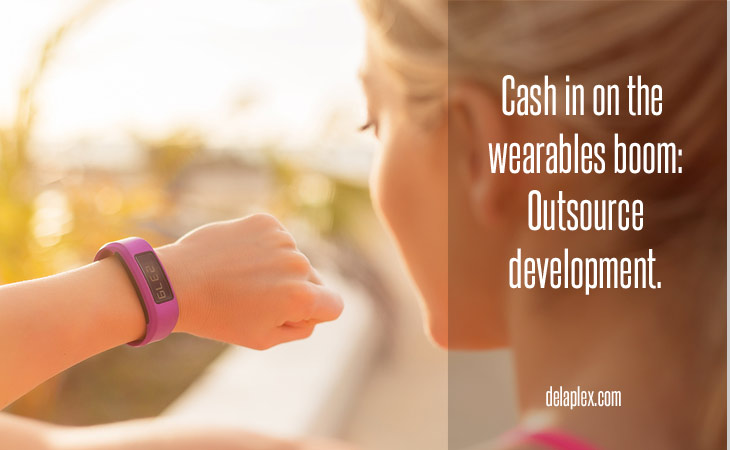
When discussing the tech world, the media is quick to use phrases such as "disruptive technology" or "the next big thing." Sometimes, the description is accurate, but sometimes the technology fizzles out as quickly as it arrived. However, when analysts describe wearable technology as the next big thing, they are not exaggerating.Wearables equip us with more power and information, which in turn can help us live our lives more proficiently.
The fitness, medical, lifestyle, gaming and infotainment industries are all leveraging wearable technology for both commercial and consumer applications.
A $50 Billion Industry in 5 Years
Despite some slow growth during the early years, wearable tech is now booming, and it is expected to see explosive growth over the next few years. In 2014, wearables had a market of between $3 and $5 billion, depending on which survey you choose, with a projected growth over the next five years to a $50 billion industry.
The estimated growth rate for wearables is no doubt part of the reason that many "big players" have released or are currently developing wearables. Google, Intel, Apple, Sony and Samsung are just a few of the major corporations who are developing products for the wearables market. However, the market is still open to small businesses, individual inventors and entrepreneurs. All that is needed is a good idea for a product and the services of an outsourced developer.
Software, hardware, UIs, oh my!
Creating a wearable that will function properly and sell well requires a special combination of skills. Wearables require software and hardware, user interfaces and sensors, miniature processors and aesthetic design. A corporation with annual sales counted in the tens of billions of dollars can afford to hire a building full of developers, each with a specific skill set needed to create a single wearable. Smaller businesses do not have that type of money to invest in developing an idea.
Outsourcing is the equalizer.
This is where outsourcing development can help equalize the competition. Outsourcers already have staff members who are experts in every skill needed to develop a wearable device as well as the hardware and software needed for your project. They stay current on new wearable products, new technologies and new development methods. They will know what components will work best for your project and what elements might prove problematic.
Outsourcing the development of your wearable product has other advantages as well. A good outsourcer will work as your technology partner and guide you through the often-confusing world of technology. They can help you determine the timeline for your project so that you can schedule your marketing and production efforts in advance.
You need not worry that you will be left out of the development, either. A reputable outsourcer will provide periodic status updates, demos and test releases so that you will always know how your project is progressing. You will always remain in control and have the final approval of the work that the outsourcer performs on your behalf.
Outsourcing development, therefore, can take care of one of the two requirements for getting in on the boom in wearables. The second requirement — a good idea — is something that only you can provide. However, a discussion of products that are already on the market or will be arriving soon might spur your creativity.
Growing niches in wearables
The healthcare field is one of the most rapidly growing industries for wearable technology. Many of the devices are designed to provide in-home monitoring over an extended period, while others can be used to assess a patient's health. For example, there are wearables that can take the wearer's temperature, blood pressure and other vital signs and transmit the information to the physician. If sleep apnea is suspected, the patient can wear a device to monitor his sleeping patterns in his own bed instead of spending the night under observation at a sleep disorder clinic. There are also wearables that can deliver medications and shoes equipped with a tracking chip for patients suffering from Alzheimer's.
Another niche that has been expanding rapidly involves wearables for animals, with a projected market of $2.6 billion by 2025, according to IDTechEx. These products go far beyond chips embedded beneath the skin or cumbersome harnesses for mounting heavy cameras. For example, there is a collar available to monitor a dog's sleeping habits, activity level and behavior patterns. Another device for horses can warn owners that a mare is about to foal by monitoring how frequently the mare lies down and the level of her sweating.
The fitness industry was one of the first pioneers in consumer wearables. Fitness bands and bracelets monitor activity level, pulse rate, distance covered, time elapsed and other factors. The information is stored for long-term analysis of changes. Shoes with embedded technology can perform the same functions, but some can also analyze the wearer's gait. Analysts predict that future development of fitness devices will include wearable technology sewn into shirts, hats or other articles of clothing that give no hint to others that they contain a device.
Aesthetics matter
Perhaps one of the most interesting developments in the wearables field is the increased emphasis on aesthetics. Wearable devices are being incorporated into attractive jewelry; Swarovski has recently collaborated on the design of wearables using high-quality crystals and other stones. There are also smart watches that are as attractive as any quality wristwatch.
Analysts predict that the wearable field will reverse a trend that has been popular in recent years — devices that perform multiple functions. Early wearables were often multi-function, but few of them were optimized to handle each function extremely well. Future wearables are more likely to focus on a specific function (or set of functions, such as monitoring vital signs) that permit maximum optimization.
What the next innovative wearable product will be remains anyone's guess. The current products are only the tip of the iceberg, and the territory is immense. Perhaps the next revolutionary wearable product will be the one you envision and create with the help of an outsourced developer.
Not just for the "big boys."
Future innovation in wearables is probably not going to be propelled by existing corporate giants. In the new creative climate, practical design ideas can be brought to market by smaller companies who leverage expert help via ousourced development providers like delaPlex.

